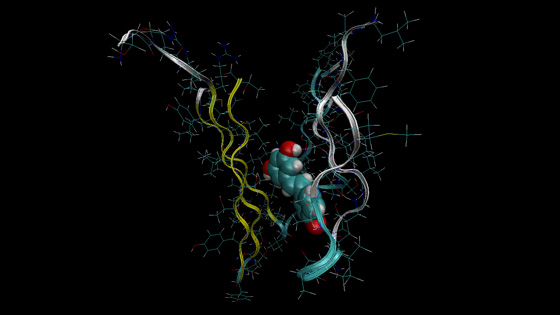
A computer model of an amyloid protein clump, which can be used to identify potential drugs (example in centre) for protein misfolding disorders. (Photo: UHN)
Alzheimer's disease accounts for the majority of dementia cases.
In Canada, half a million people are living with this disease.
Over the last decade, researchers have learned a great deal about the illness' symptoms and progression, but they are still working to unlock the mystery of how Alzheimer's begins to unfold in the brain and stop its progress.
A team of researchers lead by Dr. Donald Weaver at the Toronto Western Research Institute (TWRI) have now not only identified an abnormal protein shape common in Alzheimer's disease, but also developed a drug compound that limits its ability to wreak havoc on the brain.
Related to this story:
The research results were presented this past July at the Alzheimer's Association International Conference in Washington.
"We are obviously very excited about these findings," says Dr. Weaver, a neurologist and director of the TWRI.
"Our research continues to advance, and we believe we are essentially on the path to finding a way to stop the progression of Alzheimer's."
A two-pronged approach
Alzheimer's disease is defined by two proteins when they malfunction: beta-amyloid and tau proteins. Beta-amyloid is a series of amino acids that are important participants in the formation of amyloid plaques – or misfolded proteins that clump together – in the brains of Alzheimer's patients.
Tau proteins are found in the neurons of the central nervous system and can also lead to Alzheimer's when they clump and become defective.
The majority of Alzheimer's research focuses on one of the two proteins. But Dr. Weaver's lab – located at UHN's Krembil Discovery Tower and working under the company name Treventis Corp. – is dedicated to studying both.
As a result of this focus, a molecular modeller spent time analyzing the misfolding of both proteins, and identified a shape found in both amyloid and tau that gives them the capacity to misfold. They have called this the Common Conformational Motif (CCM).
Initially, amyloid and tau are "unclumped" and are said to be in their monomeric - simple molecule - form.
Through their random motions and changes the proteins can adopt the CCM shape. Once in the CCM shape, the protein becomes a template for other proteins to glob onto it, causing the signature plaques and deposits of Alzheimer's in the brain.
Using the new-found abnormal shape, researchers searched a database of 11.8 million compounds and identified 130 "hits" that could bind to it in both beta-amyloid and tau – they subsequently went on to improve three of these compound classes.
Developing a solution
Treventis Corp. uses organic chemistry to synthesize potential drugs to treat Alzheimer's. From the CCM-identified hits, they are now focusing on one or two compound classes as they develop a drug that prevents the misfolding of both tau and amyloid.
"We then tested the efficacy of the compounds in many different models," Dr. Weaver explains. "We were pleased to see that not only did the compounds bind to the CCM shape, but they also prevented it from misfolding in both beta-amyloid and tau proteins."
"The proteins exist naturally in the brain and, in a healthy brain, can be cleared out through natural processes," he continues. "The compounds we've developed help keep the proteins in their original, monomeric form. This allows the brain function of clearing out the amyloid to continue naturally. These findings represent a very interesting disease-modifying approach to Alzheimer's."
Funded by the
Wellcome Trust, the research team hopes to test the compound in human trials by 2018.
